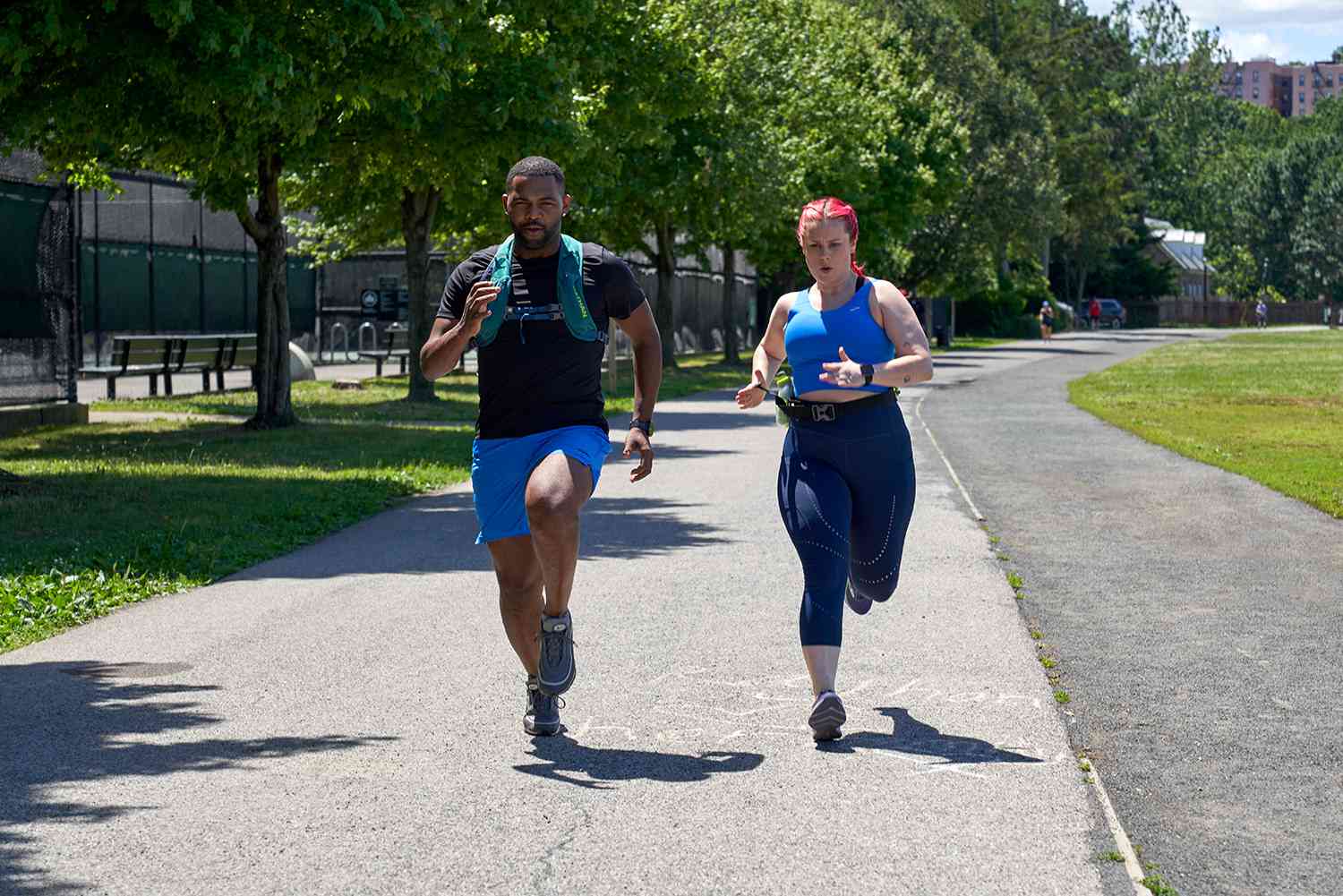

Featured
How To Start Jogging
Modified: August 21, 2023
Learn the best way to start jogging with our featured guide. Discover helpful tips and techniques for beginners to get started on their running journey.
Introduction
Are you looking to improve your fitness and embark on a new exercise routine? Jogging might just be the perfect activity for you. Not only is it a great way to burn calories and improve cardiovascular health, but it also allows you to enjoy the great outdoors and explore new places. Whether you’re a beginner or someone looking to get back into running, this article will guide you through the process of starting jogging.
Before you lace up your sneakers and hit the pavement, it’s essential to understand the numerous benefits that jogging has to offer. Running regularly can help reduce the risk of chronic illnesses, such as heart disease and diabetes, while also boosting your mood and mental well-being. Additionally, jogging is a cost-effective exercise that requires minimal equipment, making it an accessible choice for people of all fitness levels.
However, as with any new fitness endeavor, it’s crucial to approach jogging with a thoughtful plan in order to ensure a smooth and injury-free experience. Throughout this article, we will discuss everything you need to know to get started on your jogging journey.
From choosing the right gear to setting realistic goals, we will provide you with the necessary tools to kickstart your running routine. You will learn the importance of warming up and stretching, as well as how to gradually transition from walking to jogging. We will also dive into the proper running form and technique, emphasizing the significance of maintaining good posture and foot strike.
Another crucial aspect of jogging is building endurance gradually. We will explain how to increase your distance and pace over time, while also highlighting the importance of rest and recovery days. Additionally, we will explore strategies to stay motivated and overcome common obstacles that may arise during your running journey.
Lastly, we will discuss common running injuries, their prevention, and how to listen to your body if you start experiencing discomfort. Proper care and attention can help minimize the risk of injury and ensure that you can continue jogging for years to come.
So, are you ready to lace up your shoes and start jogging? Let’s dive into the world of running and discover the incredible benefits that this activity has to offer.
Choosing the Right Gear
When it comes to jogging, having the right gear is essential for both comfort and performance. The following are some key considerations to keep in mind when selecting your jogging attire and equipment.
Footwear: Invest in a good pair of running shoes that provide proper support and cushioning. Look for a shoe that suits your foot type and running style. Visit a specialty running store where experts can help analyze your gait and recommend the best shoe for you.
Apparel: Opt for lightweight and breathable clothing that allows for comfortable movement. Choose moisture-wicking materials that help keep you dry during your runs. Consider the weather conditions and dress accordingly, layering up in colder temperatures or wearing sun-protective clothing in hot and sunny conditions.
Accessories: Depending on your preferences and needs, consider some additional accessories. A good-quality sports watch or fitness tracker can help you track your progress and monitor your heart rate. Invest in a comfortable and adjustable sports armband or waist belt to securely hold your phone or music player while running. Don’t forget to protect yourself from the sun with a hat, sunglasses, and sunscreen.
Hydration: Staying hydrated is crucial during physical activity. Invest in a good water bottle or hydration pack that you can take with you on your runs. Consider the distance and duration of your runs to determine the appropriate capacity for your water bottle.
Visibility: If you plan on running in low-light conditions, make sure to wear reflective clothing or accessories to enhance your visibility to motorists and other pedestrians. You can also use a headlamp or attach LED lights to your clothing or shoes to ensure you are easily seen.
Comfort: Above all, prioritize comfort when choosing your jogging gear. Avoid clothing or shoes that are too tight or restrictive, as this can lead to discomfort and potential injuries. Experiment with different brands and styles to find what works best for you.
Remember, investing in the right gear is an investment in your own enjoyment and performance as a jogger. Take the time to select items that make you feel comfortable and confident, and you will set yourself up for a successful running experience.
Setting Realistic Goals
Setting goals is an essential part of any journey, and jogging is no exception. By establishing realistic goals, you can stay motivated and track your progress along the way. Here are some tips to help you set achievable goals for your jogging routine.
Start with a baseline: Before setting specific goals, it’s important to assess your current fitness level. This can be done by going for a short jog or even walking briskly and noting the distance and time it takes you. This will serve as your starting point and help you gauge your progress as you continue jogging.
Be specific: Rather than setting vague goals like “get fit” or “run faster,” make your goals specific and measurable. For example, aim to run a certain distance, such as completing a 5K race, or aim for a specific time to complete a mile.
Set short-term and long-term goals: It’s helpful to have both short-term and long-term goals to work towards. Short-term goals can be achieved within a few weeks or months, while long-term goals may take several months or even a year to accomplish. This will help you stay focused and motivated throughout your jogging journey.
Be realistic: While it’s important to challenge yourself, it’s equally important to set realistic goals. Consider your current fitness level, time commitment, and other commitments in your life. Setting goals that are too ambitious may lead to burnout or injuries. Gradually increasing the difficulty of your goals will ensure steady progress without overwhelming yourself.
Break it down: Sometimes, big goals can seem overwhelming. Break them down into smaller, more manageable milestones. For example, if your long-term goal is to complete a half-marathon, set smaller goals along the way, such as running a 10K race or increasing your weekly mileage. Celebrate each milestone reached, as it will keep you motivated and positive.
Track your progress: Keep a record of your runs, noting the distance, time, and any other relevant details. This will allow you to see how far you’ve come and identify areas for improvement. You can use a running app or a simple notebook to track your progress.
Adjust and reassess: As you progress in your jogging journey, it’s important to regularly reassess your goals. Your fitness level and abilities may change over time. Don’t be afraid to adjust your goals to align with your current circumstances and ambitions.
Remember, the key to setting realistic goals is finding the right balance between pushing yourself and ensuring that your goals are attainable. By setting achievable goals, you will stay motivated, track your progress, and experience the sense of accomplishment that comes with meeting your objectives.
Warming Up and Stretching
Before hitting the pavement for your jog, it’s crucial to properly warm up your body and engage in stretching exercises. Warming up prepares your muscles for the physical activity, reduces the risk of injury, and improves your overall performance. Here are some essential warm-up and stretching techniques to incorporate into your jogging routine.
Dynamic Warm-Up: Start with a dynamic warm-up to increase blood flow and warm up your muscles. Dynamic exercises involve movement and help activate the major muscle groups used during jogging. Examples of dynamic warm-up exercises include leg swings, arm circles, high knees, butt kicks, and walking lunges. Perform each exercise for 10-15 repetitions or as comfortable for your fitness level.
Cardiovascular Warm-Up: After your dynamic warm-up, engage in light cardiovascular exercises to further elevate your heart rate and warm up your entire body. This can be done by briskly walking or lightly jogging for 5-10 minutes. The goal is to increase your heart rate and break a light sweat.
Static Stretching: Once your body is warmed up, it’s time to incorporate static stretching exercises. Static stretches involve holding a position to lengthen and stretch the muscles. Focus on targeting major muscle groups such as calves, hamstrings, quadriceps, and hip flexors. Hold each stretch for 20-30 seconds without bouncing or jerking. Remember to breathe deeply and relax into each stretch. Some examples of static stretches include calf stretches, hamstring stretches, quad stretches, and hip flexor stretches.
Pre-Run Drills: In addition to warming up and stretching, incorporating pre-run drills can help improve your running form and enhance your performance. These drills target specific muscle groups and enhance coordination and stability. Some common pre-run drills include high knees, butt kicks, A-skips, B-skips, and grapevine exercises. Aim to perform 2-3 sets of each drill for 20-30 meters.
Listen to Your Body: While warming up and stretching is important, it’s essential to listen to your body and adapt your routine accordingly. If you feel any pain or discomfort during a particular exercise or stretch, modify it or choose an alternative that works for you. Everyone’s body is different, so it’s important to prioritize your comfort and safety.
Cool-Down: After your jog, don’t forget to cool down with light walking or gentle stretching exercises. This helps gradually lower your heart rate and prevent muscle stiffness and soreness. Take 5-10 minutes to walk and perform some static stretches, focusing on the major muscle groups.
Remember, warming up and stretching before your jog is essential for injury prevention and improved performance. By incorporating these practices into your routine, you ensure that your body is properly prepared for the physical demands of jogging, leading to a safer and more enjoyable experience.
Starting with a Walk-Jog Routine
If you’re new to jogging or haven’t been active for a while, starting with a walk-jog routine is an excellent way to ease into your jogging journey. This approach allows your body to gradually adapt to the demands of running and helps prevent injuries. Follow these steps to safely transition from walking to jogging.
Step 1: Establish a baseline: Before starting your walk-jog routine, determine your current fitness level. This can be done by going for a brisk walk or light jog and noting the distance and time it takes you to complete. This baseline will help you gauge your progress as you gradually increase the running portion of your routine.
Step 2: Warm up: Begin with a dynamic warm-up as mentioned in the previous section. This will increase blood flow to your muscles and prepare them for the activity ahead.
Step 3: Walk-jog intervals: Start with a ratio of walking to jogging that feels comfortable for you. For example, you could begin with a 2:1 ratio, walking for 2 minutes and jogging for 1 minute. Repeat this interval for a total of 20-30 minutes. As your fitness level improves, gradually increase the jogging duration while decreasing the walking intervals.
Step 4: Listen to your body: Pay attention to how your body feels during the workout. It’s normal to feel some exertion, but if you experience pain or excessive fatigue, it’s important to slow down or take a break. Push yourself, but don’t overdo it. It’s better to progress gradually than to risk injury.
Step 5: Gradually increase intensity and duration: Over time, aim to increase the jogging portion of your routine while reducing the walking intervals. Incorporate small increments of progress, such as adding 1-2 minutes of jogging per session or extending the total workout time by 5-10 minutes. Remember, steady progress is key to building endurance safely.
Step 6: Rest and recovery: Allow your body time to rest and recover between workouts. This will help prevent overuse injuries and allow your muscles to rebuild and strengthen. Incorporate rest days into your routine and listen to your body’s signals for when it needs a break.
Step 7: Stay consistent: Consistency is important for progress. Try to stick to a regular schedule, aiming for at least three workouts per week. This will help you establish a routine and allow your body to adapt more effectively to the demands of jogging.
Remember, starting with a walk-jog routine sets a solid foundation for your jogging journey. By gradually increasing the intensity and duration of your jogging intervals, you will build stamina and endurance, paving the way for longer and more sustained running sessions in the future.
Proper Running Form and Technique
Having proper running form and technique is essential for not only maximizing your performance as a jogger but also minimizing the risk of injuries. Here are some key tips to help you maintain good form while running:
Posture: Keep your posture upright and aligned. Avoid hunching forward or leaning backward. Engage your core muscles to maintain stability and proper alignment throughout your run.
Head and Eyes: Keep your head in a neutral position, looking straight ahead. Avoid looking down at your feet, as this can cause strain on your neck and upper back. Maintaining a forward gaze helps ensure proper alignment and allows you to be aware of your surroundings.
Shoulders and Arms: Relax your shoulders and keep them away from your ears. Allow your arms to swing naturally back and forth, maintaining a 90-degree angle at your elbows. Avoid crossing your arms in front of your body, as this can throw off your balance.
Hand Position: Maintain a relaxed and light fist with your thumbs resting on top of your fingers. Avoid clenching your fists too tightly, as this can cause unnecessary tension in your arms and upper body.
Stride Length and Cadence: Aim for a comfortable stride length and cadence (number of steps per minute). Your stride should not be too long or too short. Short, quick steps can help reduce the impact on your joints and improve overall efficiency. A cadence of around 170-180 steps per minute is often recommended.
Foot Strike: Pay attention to how your feet land on the ground. Aim for a mid-foot or forefoot strike, where your foot lands beneath your body and rolls forward. Avoid overstriding, where your foot lands in front of your body, as this can increase the risk of injury. Finding the right foot strike for you may differ based on your running form and individual biomechanics.
Breathing: Establish a rhythmic breathing pattern that works for you. Breathe deeply from your diaphragm and focus on exhaling fully to ensure efficient oxygen intake. Some runners find it helpful to coordinate their breathing with their stride, such as taking two steps for inhaling and two steps for exhaling.
Listen to Your Body: It’s important to listen to your body and make adjustments as needed. If you experience pain or discomfort in a specific area, take note of your form and technique. Pay attention to any asymmetries or imbalances and seek professional advice if necessary.
Remember, practice makes perfect when it comes to running form and technique. Be mindful of these tips during your runs and gradually work on improving your form. With time and practice, proper running form will become second nature and contribute to a more efficient and enjoyable jogging experience.
Building Endurance Gradually
Building endurance is a critical component of becoming a stronger and more capable jogger. By gradually increasing your distance and duration, you can improve your cardiovascular fitness and stamina. Here are some key strategies to help you build endurance effectively:
Start with a baseline: Determine your current endurance level by tracking the distance or time you can comfortably jog without feeling overly fatigued. This will serve as your starting point for gradually building your endurance.
Set incremental goals: Break your overall endurance goal into smaller, more attainable milestones. Aim to increase your running distance or time by no more than 10% each week. This gradual progression allows your body to adapt and reduces the risk of overuse injuries.
Mix up your runs: Incorporate a combination of longer, slower runs and shorter, faster runs into your training plan. Regularly challenging yourself with shorter, faster runs can help improve your overall speed, while longer, slower runs build endurance.
Interval training: Incorporate interval training into your routine. This involves alternating between periods of higher intensity running and active recovery or lower intensity jogging or walking. For example, you could run at a faster pace for 1-2 minutes, followed by a period of slower jogging or walking. Repeat these intervals several times during your run.
Gradual distance increase: Increase your running distance gradually over time. Aim to add no more than half a mile to a mile to your total distance each week. This allows your body to adapt and helps prevent burnout or injury.
Consistency and frequency: Consistency is key when it comes to building endurance. Aim for at least three to four running sessions per week. Regularly exposing your body to the demands of running helps condition your cardiovascular system and muscles.
Slow down your pace: When focusing on building endurance, it’s important to prioritize distance over speed. Slow down your pace during longer runs to maintain a comfortable and sustainable effort. As your endurance improves, you can gradually increase your pace.
Listen to your body: Pay attention to how your body feels during and after your runs. Some fatigue and muscle soreness are normal, but listen to any signs of pain or excessive fatigue that could indicate overtraining or injury. Adjust your training plan accordingly and give yourself adequate rest days.
Stay patient and be consistent: Building endurance takes time and consistency. Be patient with yourself and trust the process. Celebrate each milestone reached along the way and focus on the progress you’re making.
Remember, the key to building endurance gradually is finding the right balance between increasing your running volume and allowing your body time to adapt and recover. By following these strategies, you’ll steadily improve your endurance, making longer runs feel more comfortable and enjoyable.
Importance of Rest and Recovery
Rest and recovery are vital components of a successful jogging routine. While it can be tempting to push yourself to the limit and go for runs every day, giving your body time to rest and recover is essential for optimal performance and injury prevention. Here’s why rest and recovery are so important:
Muscle Repair: When you engage in physical activity, your muscles experience micro-tears. These tears need time to repair and rebuild, which is facilitated during periods of rest. Allowing your muscles to recover properly helps prevent overuse injuries and promotes stronger, more resilient muscles.
Energy Restoration: Resting and recovering allows your body to replenish its energy stores. Running requires both physical and mental energy, and adequate rest ensures that your body has enough fuel to perform optimally during your runs. Without proper rest, you may experience fatigue and decreased performance.
Prevention of Overtraining: Overtraining occurs when you consistently push your body beyond its limits without allowing sufficient time for recovery. This can lead to increased fatigue, decreased performance, and an increased risk of injury. Taking regular rest days helps prevent overtraining and allows your body to adapt and progress more effectively.
Injury Prevention: Rest and recovery play a crucial role in injury prevention. Pushing your body too hard without giving it time to recover can lead to overuse injuries such as stress fractures, tendinitis, or muscle strains. Proper rest allows your body to repair and rebuild, reducing the risk of these injuries.
Mental Well-being: Rest days are not just for your body; they are essential for your mental well-being too. Continuous physical exertion without breaks can lead to burnout, decreased motivation, and even mental health issues. Taking rest days allows you to relax, recharge, and approach your next run with a refreshed mindset and enthusiasm.
Performance Improvement: Rest and recovery actually contribute to improved performance. When you give your body time to rest, it adapts and becomes stronger. Your muscles become more efficient, and you’re able to increase your endurance and speed over time. Embracing rest and recovery as part of your routine can result in better performance and long-term progress.
Listen to Your Body: It’s important to listen to your body and pay attention to its signals. If you feel excessively tired, experience persistent muscle soreness, or notice a decline in performance, it’s a sign that you may need more rest. Adjust your training plan accordingly and don’t hesitate to take extra rest days when needed.
Remember, rest and recovery are not signs of weakness or laziness but rather essential elements of a balanced and sustainable jogging routine. By incorporating rest days into your training plan, you allow your body to heal, recharge, and come back stronger for your next run.
Staying Motivated
Staying motivated is key to maintaining a consistent jogging routine. While it’s completely normal to have fluctuations in motivation, there are various strategies you can implement to stay on track and keep your enthusiasm high. Here are some tips to help you stay motivated throughout your jogging journey:
Set Goals: Having clear and specific goals can provide you with a sense of direction and purpose. Whether it’s completing a certain distance, participating in a race, or achieving a personal best time, set goals that excite and challenge you. Break them down into smaller milestones and celebrate your achievements along the way.
Find Your Why: Understand and remind yourself of why you started jogging in the first place. Whether it’s to improve your health, lose weight, relieve stress, or simply enjoy the outdoors, tapping into your underlying motivation can help you stay committed even during tougher times.
Track Your Progress: Keep a record of your runs and track your progress. Seeing improvements in your pace, distance, or endurance can be highly motivating. Use a running app or keep a running journal to log your runs, and look back at how far you’ve come.
Mix Up Your Routine: Avoid getting stuck in a monotonous routine by incorporating variety into your jogging routine. Explore new routes, try different types of runs (such as hills or intervals), or listen to new music or podcasts while running. Adding variety can make your runs more enjoyable and prevent boredom.
Buddy Up: Find a jogging buddy or join a running group to keep each other accountable and motivated. Having a supportive partner or group can make running more enjoyable and help you stay committed to your routine. Plan regular runs together or participate in virtual races or challenges as a group.
Reward Yourself: Treat yourself for reaching milestones or achieving your goals. Rewards can serve as incentives and keep your motivation high. It could be buying yourself new running gear, enjoying a massage, or indulging in a favorite healthy treat.
Visualize Success: Picture yourself accomplishing your goals and visualize the positive outcomes of your running journey. Visualizing success can help boost your confidence and motivation, making it easier to stay committed and focused on your goals.
Join Virtual Challenges: Participate in virtual races or challenges to add a sense of competition and camaraderie. Many running apps and websites offer virtual races where you can compete against others or work towards specific targets. These challenges can provide a sense of excitement and motivation to keep pushing yourself.
Stay Positive and Celebrate Small Wins: Cultivate a positive mindset and celebrate small wins along the way. Recognize and appreciate the effort you put into your runs, even if they may not always go as planned. Remind yourself of the progress you’ve made and the positive impact that running has had on your overall well-being.
Remember, motivation might ebb and flow, but by implementing these strategies and finding what works best for you, you can stay motivated throughout your jogging journey. Embrace the process, stay focused on your goals, and enjoy the countless benefits that running has to offer.
Common Running Injuries and Prevention
As with any physical activity, jogging carries the risk of certain injuries. Being aware of these common running injuries and taking preventive measures can greatly reduce the likelihood of experiencing them. Here are some of the most common running injuries and how to prevent them:
Runner’s Knee: Runner’s knee, or patellofemoral pain syndrome, is characterized by pain around the kneecap. To prevent runner’s knee, make sure you have proper running shoes that provide adequate support and cushioning. Gradually increase your mileage and avoid sudden increases in training volume. Strengthening the muscles around your knees, such as the quadriceps and hamstrings, can also help prevent this injury.
Shin Splints: Shin splints cause pain along the shinbone (tibia), and are often caused by overuse or improper running form. To prevent shin splints, make sure you have suitable shoes with proper support and cushioning. Gradually increase your running intensity and avoid running on hard surfaces when possible. Strengthening the muscles in your calves and shins, as well as incorporating cross-training exercises, can help prevent this injury.
Plantar Fasciitis: Plantar fasciitis causes heel pain and is the inflammation of the plantar fascia, a band of tissue in the foot. To prevent plantar fasciitis, choose running shoes with good arch support. Gradually increase mileage and avoid sudden changes in running intensity. Stretch your calves and feet regularly, and incorporate foot exercises to strengthen the muscles in your feet.
Achilles Tendonitis: Achilles tendonitis involves inflammation of the Achilles tendon, which connects the calf muscles to the heel. To prevent Achilles tendonitis, warm up properly before running and incorporate dynamic stretching exercises for the calves. Gradually increase your running intensity and avoid excessive hill training or sudden changes in training volume. Strengthening the calf muscles and using appropriate footwear can also help prevent this injury.
IT Band Syndrome: IT band syndrome is characterized by pain on the outer side of the knee, caused by inflammation of the iliotibial band. To prevent IT band syndrome, make sure you have proper running shoes and avoid running on slanted surfaces when possible. Gradually increase your running intensity and incorporate strength training exercises that target the hip and glute muscles. Regularly foam roll or perform self-massage along the IT band to alleviate tightness.
Stress Fractures: Stress fractures are small cracks or breaks in the bone and commonly occur from overuse or repetitive impact. To prevent stress fractures, make sure to gradually increase your running volume and intensity. Incorporate strength training exercises to improve bone density and muscle strength. Choose appropriate running surfaces and vary your running routes to avoid excessive repetitive impact on the same areas.
Listen to Your Body: One of the most crucial aspects of preventing running injuries is listening to your body. Pay attention to any pain, discomfort, or changes in your running mechanics. If you experience persistent pain or discomfort, don’t push through it. Rest, seek professional advice if needed, and modify your training accordingly.
Proper Recovery: Alongside injury prevention, proper recovery is essential for maintaining your running health. Allow your body sufficient time to rest and recover between runs. Incorporate cross-training exercises, stretching, and foam rolling into your routine to promote muscle recovery and prevent imbalances.
Remember, injury prevention is key to sustaining a long-term jogging routine. By incorporating these preventive measures, listening to your body, and taking appropriate rest and recovery, you can minimize the risk of common running injuries and enjoy a safe and fulfilling running experience.
Conclusion
Congratulations on taking the first step towards starting your jogging journey! By following the tips and guidelines outlined in this article, you are well-equipped to embark on a safe and enjoyable running routine.
Remember, choosing the right gear, setting realistic goals, and warming up properly are essential to ensure a smooth and injury-free experience. Starting with a walk-jog routine allows your body to gradually adapt to the demands of running, while maintaining proper form and technique prevents injuries and optimizes performance.
Building endurance gradually and incorporating rest and recovery into your routine are crucial for long-term progress. It’s important to stay motivated by setting goals, tracking your progress, and finding enjoyment in the process. Be mindful of common running injuries and take preventive measures to keep yourself healthy and injury-free.
As you continue on your jogging journey, remember to listen to your body and make adjustments as needed. Every individual is unique, so it’s important to find what works best for you and prioritize your comfort and safety.
Through dedication, persistence, and a positive mindset, you will witness the transformative power of jogging. Not only will you experience improved fitness and health, but you will also cultivate mental strength and a sense of accomplishment with each run. Embrace the journey, celebrate your progress, and enjoy the incredible benefits that jogging has to offer.
Now, it’s time to lace up your shoes, step outside, and begin your jogging adventure. Happy running!









